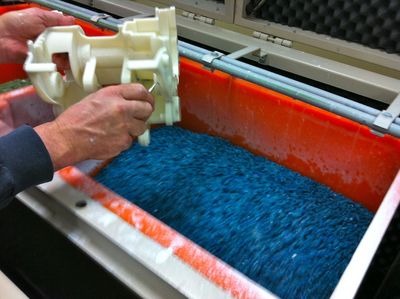 During our visit to Stratasys’ RedEye On Demand facility the other day, we observed a fascinating finishing process that might be applicable to personal 3D prints, given the appropriate equipment.
During our visit to Stratasys’ RedEye On Demand facility the other day, we observed a fascinating finishing process that might be applicable to personal 3D prints, given the appropriate equipment. This process solves one of the flaws in objects produced by personal (and some commercial) 3D printers: layer visibility. If you look closely, it’s often very easy to see the layers put down by your 3D printer. It’s even more noticeable by touch. To some, this effect devalues the objects because they’re not as smooth as you’d find from conventional manufacturing techniques, such as injection molding.
The process used by RedEye is actually quite straightforward: printed objects are placed in a tub full of agitated pieces. The pieces rub against the object and gradually “shine it up”. We examined objects finished with this process and found them to be completely smooth to the touch and any layering was entirely obscured. The objects appeared to have been made with injection molding, but weren’t. Better yet, the technician indicated the process takes only an hour or so to complete an object.
Obviously there are issues, such as selecting the right size of pieces to be able to infiltrate all nooks and crannies of a given object and the manual process of picking out pieces lodged inside corners and hollows. But it appears that RedEye has figured this one out through lengthy experimentation.
We’re wondering if an analogous process could be developed for personal 3D printers, which typically have dramatically visible layering. An agitation box could be designed to perform this work, although some experimentation would be required to determine the best practices and agitation materials. Perhaps this would be an excellent KickStarter project?


Would you happen to know the right kind of material to use in such a device? We've tried several that don't work.
Would you happen to know the right kind of material to use in such a device? We've tried several that don't work.
This is a common process, not only for 3D prints. It's called vibratory finishing:
http://en.wikipedia.org/wiki/Vibratory_finishing
You can buy the equipment required at any well-stocked tool store, like Harbor Freight. Just search for "vibratory tumbler". I found one for $55, which is pretty damn cheap (but you also need some media to put in it).
This is a common process, not only for 3D prints. It's called vibratory finishing:
http://en.wikipedia.org/wiki/Vibratory_finishing
You can buy the equipment required at any well-stocked tool store, like Harbor Freight. Just search for "vibratory tumbler". I found one for $55, which is pretty damn cheap (but you also need some media to put in it).